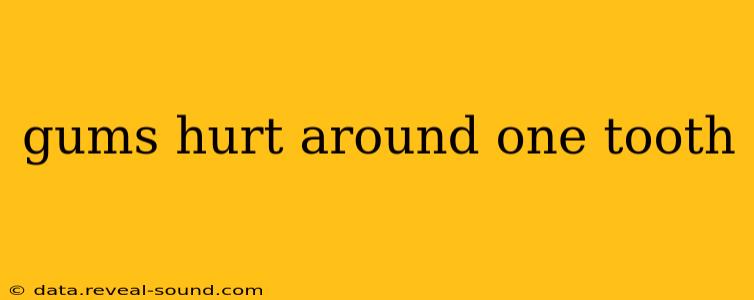Experiencing gum pain localized around a single tooth can be alarming, but understanding the potential causes can ease your concerns and guide you towards appropriate treatment. This discomfort isn't simply a minor inconvenience; it often signals an underlying dental issue that requires attention. Let's explore the common culprits and what you can do.
What Could Be Causing Gum Pain Around One Tooth?
Several factors can contribute to localized gum pain. Pinpointing the exact cause is crucial for effective treatment. Here are some of the most likely possibilities:
-
Gingivitis: This early stage of gum disease is characterized by inflammation and redness of the gums. It's often caused by poor oral hygiene, allowing plaque and bacteria to build up. The inflammation can be concentrated around a single tooth if that area is particularly prone to plaque accumulation.
-
Periodontitis: A more advanced form of gum disease, periodontitis involves the destruction of the tissues and bone supporting your teeth. Localized periodontitis can cause intense pain and sensitivity around the affected tooth.
-
Abscess: A gum abscess is a pus-filled pocket that forms in the gums, typically due to an infection. The intense throbbing pain is usually centered around one tooth. This requires immediate professional attention.
-
Dental Cavity: While cavities primarily affect the tooth itself, the resulting inflammation and infection can spread to the surrounding gums, leading to pain.
-
Trauma: An injury to the gum tissue around a specific tooth, from biting down on something hard or accidental trauma, can trigger inflammation and pain.
-
Food Impaction: A piece of food lodged between your teeth can irritate the gums, causing discomfort.
-
Teeth Grinding (Bruxism): While often affecting multiple teeth, bruxism can sometimes lead to localized gum inflammation and pain, particularly if the grinding pressure is concentrated on one area.
What Should I Do if My Gums Hurt Around One Tooth?
Ignoring gum pain is never advisable. Here's a step-by-step guide on how to proceed:
-
Improve Oral Hygiene: Brush and floss thoroughly, paying extra attention to the area around the affected tooth. Use a soft-bristled toothbrush to avoid further irritation.
-
Rinse with Saltwater: A warm saltwater rinse can help soothe inflammation and reduce pain. Dissolve half a teaspoon of salt in a cup of warm water and gently swish it around your mouth.
-
Over-the-Counter Pain Relief: Ibuprofen or acetaminophen can help manage the pain while you seek professional help.
-
Schedule a Dental Appointment: This is the most crucial step. A dentist can accurately diagnose the problem and recommend the appropriate treatment. Delaying professional care can worsen the condition and lead to more significant problems.
How Can I Prevent Gum Pain Around One Tooth?
Prevention is key to maintaining healthy gums. These practices can significantly reduce your risk of experiencing gum pain:
-
Maintain Excellent Oral Hygiene: Brush twice daily for two minutes each time, and floss daily.
-
Regular Dental Checkups: Schedule regular visits to your dentist for professional cleanings and examinations.
-
Healthy Diet: A balanced diet contributes to overall health, including oral health.
-
Limit Sugary and Acidic Foods and Drinks: These can contribute to tooth decay and gum disease.
-
Quit Smoking: Smoking is a major risk factor for gum disease.
-
Manage Stress: Stress can worsen inflammation throughout the body, including the gums.
Can a Tooth Infection Cause Gum Pain?
Yes, a tooth infection (abscess) is a common cause of localized gum pain. The infection can spread from the tooth to the surrounding gum tissue, causing swelling, redness, and intense pain. A tooth infection is a serious condition that requires immediate professional treatment with antibiotics and often drainage of the abscess.
Is Gum Pain Around One Tooth Always Serious?
While not always a sign of something severe, localized gum pain shouldn't be dismissed. It's best to seek professional help to rule out underlying conditions like periodontitis or an abscess. Early diagnosis and treatment are crucial for preventing complications.
When Should I See a Dentist for Gum Pain?
You should schedule an appointment with your dentist immediately if:
- The pain is severe or persistent.
- Your gums are swollen, red, or bleeding excessively.
- You have a fever or notice pus around the affected tooth.
- You experience difficulty opening your mouth or chewing.
Ignoring gum pain can lead to serious consequences, including tooth loss. Early intervention is key to preventing further damage and maintaining good oral health. Don't hesitate to seek professional help if you're experiencing gum pain around one tooth.
